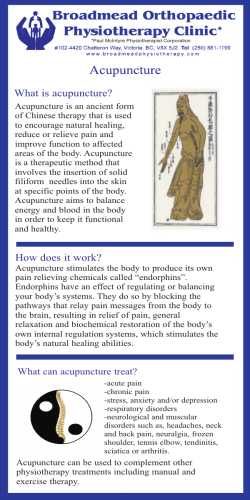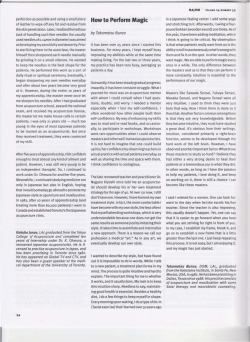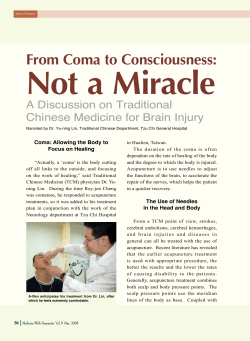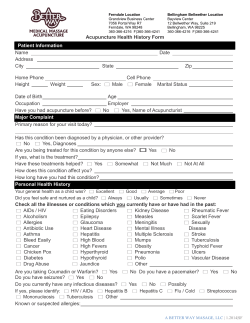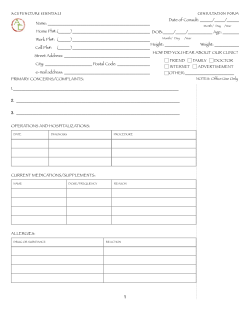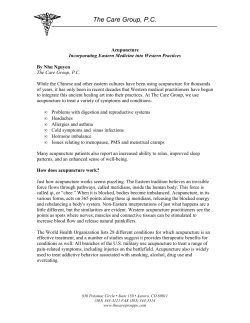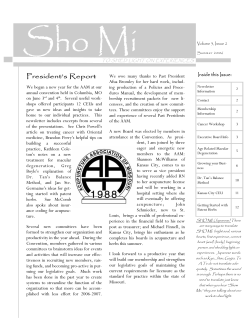
Document 222199
Hindawi Publishing Corporation Evidence-Based Complementary and Alternative Medicine Volume 2012, Article ID 875284, 7 pages doi:10.1155/2012/875284 Review Article How to Design the Control Group in Randomized Controlled Trials of Acupuncture? Jaung-Geng Lin,1 Chao-Hsun Chen,1, 2 Yu-Che Huang,1 and Yi-Hung Chen3 1 School of Chinese Medicine, China Medical University, No. 91 Hsueh-Shih Road, Taichung 40402, Taiwan Hospital Department of Health Executive Yuan, No. 80, Sec. 2, Zhongzheng Road, Puxin Township, Changhua County 51341, Taiwan 3 Graduate Institute of Acupuncture Science, China Medical University, No. 91 Hsueh-Shih Road, Taichung 40402, Taiwan 2 Chang-Hua Correspondence should be addressed to Jaung-Geng Lin, [email protected] and Yi-Hung Chen, [email protected] Received 3 March 2012; Accepted 2 May 2012 Academic Editor: Gerhard Litscher Copyright © 2012 Jaung-Geng Lin et al. This is an open access article distributed under the Creative Commons Attribution License, which permits unrestricted use, distribution, and reproduction in any medium, provided the original work is properly cited. In evidence-based medicine, randomized controlled trials (RCTs) are the preferred method for evaluating the efficacy of interventions. In regard to acupuncture RCTs, the most difficult issues are the design of the control group and implementation of the principle of “double-blinding.” We compared the advantages and limitations associated with different control group designs in acupuncture RCTs, to assist researchers in this field. 1. Introduction 1.1. The WHO Promotes the Use and Research of Acupuncture. Acupuncture is a convenient, effective, and simple form of traditional Chinese medicine that has few side effects [1]. Thus, it is often the first therapy that patients consider for a wide range of complaints where medicine is lacking and is the most widely used complementary and alternative medicine worldwide. In 1979, the World Health Organization (WHO) issued its first report on traditional medicine and described 43 categories of symptoms treatable by acupuncture; in 1996, the list was expanded to 64 [2]. This fact alone shows the value of acupuncture worldwide. In 1995, the WHO “Guidelines for Clinical Research on Acupuncture” [3] stipulated three criteria for good acupuncture studies: validity, reliability, and statistical significance (P value). Thus, at every stage of research, from basic studies to clinical trials, these criteria are paramount in any attempt to explain the function and effect of acupuncture. 1.2. Acupuncture RCTs Are Needed. Evidence-based medicine (EBM) [4] has become the gold standard among researchers, ever since the term was coined by Guyatt et al. in his paper published in JAMA in 1992 [5]. Randomized clinical trials (RCTs) belong to the Ib [6] level of EBM and therefore provide reliable criteria for study validity. Factors influencing the validity of RCTs include [3] patient selection, study size, site(s) of investigation, blinding techniques, randomization, design of the control group, crossover studies (usually inappropriate for acupuncture), and the strategic approach. Well-designed, properly conducted RCTs also include statistical analysis by a biostatistician to ensure that the results are statistically valid. 1.3. The Importance of a Control Group in Acupuncture RCTs. The ongoing debate about the therapeutic effects of acupuncture for some diseases [7–12] means that RCTs are needed to evaluate the efficacy of acupuncture. Such trials must include an appropriate control group [13]. A welldesigned control group not only increases reliability of the study but also improves its blinding, which further affects the study results [14]. One researcher [15] has questioned the consistently positive clinical trials of acupuncture from countries in East Asia. His systematic review of controlled trials noted that 2 six studies had insufficient blinding. Inadequate concealment from the control group and lack of randomization yielded a higher ratio of positive results in these studies. Furthermore, any mistakes in selection or having a poorly designed control group may lead to misinterpretation of results or misleading statements [16]. The purpose of this study was to systematically review the construction of control groups in RCT acupuncture studies published over the last few decades. 2. Methods A literature search was performed using the PubMed English language database, using the search keywords “acupuncture” and “placebo needle.” We included studies that met the following criteria: randomized control trials (RCTs) that adopted a double-blind, single-blind, or nonblind design. We chose studies that we considered to be representative for each category of control group design. We focus our analysis on the design of control groups in acupuncture studies, instead of evaluating the efficacy of acupuncture in each study. 3. Results 3.1. The Types, Advantages, and Limitations of Control Groups in Acupuncture RCTs. A survey of the literature reveals that 11 different designs exist for control groups in acupuncture RCTs, as shown in Table 1. Among these 11 designs, those classified under 1–5 have no needle intervention, those under 6–8 vary from the treatment group according to the location and depth of needle insertion, those under 9-10 use assistant tools on the skin surface, while the last design comprises multiple methods using paired subjects/controls. Advantages and limitations associated with each type are listed in Table 1. 4. Discussion 4.1. The Ideal Control Group. The purpose of the control group is to determine the effect of the intervention by properly eliminating any placebo effect produced by the test group. Therefore, RCT study designs must include at least 1 control group. Importantly, the control group must experience the same placebo effect as the test group, and ideally participants and researchers are blinded as to whether participants receive treatment or placebo. An ideal acupuncture control group must include three conditions. First, the design should be accepted by the study subjects, who must be blinded as to their assigned treatment group. Second, the curative effects should be minor and not give rise to special therapeutic effects that influence the results. Third, all other conditions for controls, excluding the intervention, should be identical to those used for the test group. 4.2. Design Strategy. Four different strategies for designing control groups have been used alone or in combination in recent acupuncture RCTs: (1) absence of acupuncture needle insertion, (2) different location of inserted acupuncture Evidence-Based Complementary and Alternative Medicine needles, (3) different depth of insertion, and (4) the use of assistant tools. In regard to the absence of acupuncture needle insertion, the control group employed an imitative puncture action and no acupuncture, performed at specific acupoints, nonspecific acupoints, or sham acupoints. In regard to different locations for inserted acupuncture needles, specific acupoints consisted of the acupoints applied in the test group according to the meridian method of acupuncture, while sham acupoints comprised the points drifting off the specific acupoints or meridian above 0.5 Bcun and not on the meridian or known acupoints. However, the optimal distance for drifting off the specific acupoints or meridian remains controversial. Nonspecific acupoints are acupoints with nontherapeutic effects or minor effects that have been observed in previous research. In regard to different depth of insertion, needle insertion depths are categorized as superficial, minimal, or deep acupuncture. Superficial acupuncture does not pierce the epidermis. In minimal acupuncture, the needle penetrates to a depth of less than 4 mm and does not cause “de-chi.” Deep acupuncture involves needle passage through the hypodermis to a depth of more than 5 mm, usually 10–20 mm, and often causes “dechi.” In reference to the use of assistant tools, placebo needles [17–20] such as the Streitberger’s needle, Park Sham Device, or Takakura’s needle use a blunt tip and are tapped onto the skin. It is important to note that, although these four strategies were adopted, the control group in acupuncture RCTs is less of an ideal comparator than when it is used in drug RCTs. 4.3. Laser Acupuncture and Transcutaneous Electrical Nerve Stimulation (TENS). Laser acupuncture and TENS usually serve as nonacupuncture contrasts, meaning that they are not involved in needle insertion. Laser acupuncture has been clinically applied since the 1970s [21]. Laser acupuncture is defined as the simulation of traditional acupuncture points with low-intensity, nonthermal laser irradiation. The therapeutic effects are related to not only wavelength, irradiance, and beam profile, but also skin properties such as thickness, age, and pigmentation [21]. Laser acupuncture may be beneficial for conditions ranging from pain relief, hiccups to enuresis, and postoperative nausea and vomiting [22, 23]. These possible therapeutic effects may mean that using laser acupuncture as an intervention in the control group may cause underestimation of acupuncture effects. TENS is a noninvasive analgesic technique that is usually used to relieve nociceptive, neuropathic, and musculoskeletal pain [24]. Evidence from animal studies has shown that TENS reduces ongoing nociceptive cell activity and sensitization in the central nervous system when applied to somatic receptive fields. It is hypothesized that low-intensity TENS relieves pain by a segmental mechanism, while higher intensity TENS activates extrasegmental descending pain inhibitory pathways [25]. Because of these possible therapeutic effects, using TENS as the control group intervention may cause underestimation of acupuncture effects. Moreover, the procedure of TENS differs from acupuncture. Therefore, blinding is impossible. It is noted that TENS should not be applied on the CG: standard western medicine; TG: acupuncture [43] Alternative contrast CG: nonpenetrating intervention, for To assess the different effects of Nonacupuncture example, TENS or laser acupuncture; acupuncture, TENS, and laser accontrast TG: acupuncture [44, 45] upuncture CG: mock nonpenetrating intervention, No effects of for example mock-TENS or mock laser nonacupuncture acupuncture; contrast TG: acupuncture [46] CG: insertion points are not acupoints or Sham acupuncTo compare the effects of acumeridians; ture contrast points with sham points TG: acupuncture at acupoints [47, 48] CG: acupuncture at acupoints which are considered to produce no or only minor Nonspecific sites To compare the specific effects of effects; contrast acupuncture points TG: acupuncture at specific acupoints related to the objective illness [49, 50] (2) (3) (4) (5) (6) (7) To observe whether the therapeutic effects of acupuncture are greater than those of a nonpenetrating placebo intervention To compare the effects of acupuncture and western medicine CG: standard western medicine (with [41] or without [42] placebo acupunc- To compare the effects of western ture); medicine and western medicine TG: standard western medicine and plus acupuncture acupuncture Complementary contrast To assess the effects of acupuncture CG: not receiving any treatment; TG: acupuncture [40] Purpose Nontreatment contrast Method (1) Number Categories Limitation No blinding; placebo effects of acupuncture are not eliminated. Observe the progression of the This treatment would be contrary to condition and patient recovery medical ethics when treatment involves acute or severe conditions Blinding is inadequate unless placebo Clarify the costs and side effects acupuncture is used. of acupuncture as the complemen- Comparisons with standard treatments tary therapy cannot be made, and the β error may not be correct Demonstrate the effectiveness of No blinding; placebo effects of acupuncacupuncture as the alternative theture are not eliminated, resulting in the β rapy and assess the costs and side error effects It is impossible to ensure blinding because Similar amounts of time and atten- of the substantial differences between tion are spent on each group, the- the CG intervention and acupuncture. reby helping to eliminate some of The CG intervention may have therapeuthe placebo effect tic effects. The effects of acupuncture are underestimated If the TG receives TENS or laser acupuncture, elimination of the placebo effect and blinding can be It is impossible to ensure blinding because assured. of the substantial differences between the The CG intervention has no theraCG intervention and acupuncture peutic effects and allows the observation of the progression of the condition and patients’ recovery The effects of acupuncture on pain are underestimated. The needling methods are the Having no uniform protocol for the sham same in the CG and TG, result- points precludes accurate comparison of ing in an optimal elimination of the results and conditions. placebo effect, and blinding can be Participants with previous acupuncture performed experience may be conscious of the difference in acupoint site(s), which influences the blinding Needling methods are the same The effects of acupuncture on pain are in the CG and TG, resulting in underestimated. an optimal elimination of placebo Selecting an unsuitable acupoint in the effect, and blinding can be perCG would render the result invalid formed Advantage Table 1: Acupuncture study control group designs. Evidence-Based Complementary and Alternative Medicine 3 CG: Streitberger’s needle, Park Sham Device, or Takakura’s needle with a blunt Placebo needle tip was tapped onto the skin; contrast TG: Streitberger’s needle, Park Sham Device, or Takakura’s needle with a real needle [17–20] Combined multiple methods contrast (10) (11) Advantage The blinding and elimination of CG: medicine and acupuncture placebo; placebo effects were enforced to To reduce the psychological influcontrast the specific therapeutic TG: acupuncture and placebo medicine ence effects between acupuncture and [53] medicine CG: placebo needles inserted into acupoints and real needles inserted into To produce similar therapeutic Blinding was effective, and the sham points; experience in the 2 groups; prononspecific effect of placebo neeTG: real needles inserted into acupoints mote blinding and eliminate pladles was reduced and placebo needles inserted into sham cebo effects points [54] Participants with previous acupuncture experience may be conscious of the difference in acupoint site(s), which affects the blinding The procedure is difficult to use in longterm research The major limitation of placebo needles is the associated lack of the “de-chi” sensation. Certain body sites cannot undergo acupuncture with these devices, such as the fingers, toes, and scalp, as well as The placebo effect and blinding are To observe whether real acupuncsites that require transverse insertion or regarded as optimal, and, thus, the ture is more effective than placeoblique insertion. protocol has been widely used with bo acupuncture These devices do not overcome the probgood confidence lem of double-blinding [33]. The needling methods in the TG had to be limited, thereby reducing the effects; thus, this procedure cannot be used in longterm research The physiological reaction in the control group is minimal; the procedure is easily manipulated and suitably applied without requiring a novel study design; the blinding is effective The operating locations were restricted to areas patients could not see, such as the neck, upper back, and dorsal side of limbs. The sensation was minimal and “de-chi” was not attained, which influenced the blinding for patients with previous experience of acupuncture; thus, the protocol cannot be used in long-term research CG: Control group; TG: Test group; TENS: Transcutaneous electrical nerve stimulation; ∗ Minimal acupuncture was termed superficial acupuncture in some studies [51]. (b) (a) Superficial acupuncture contrast (9) CG: dull needles or other tools (e.g., needle tube, toothpicks) are slapped on To examine whether acupuncture acupoints and tapped on them; dull is more effective than placebo needles do not prick the skin; acupuncture TG: standard acupuncture [52] Minimal acupuncture contrast∗ Purpose Limitation Potential therapeutic effects in the control group. To increase the efficacy of blinding, CG: insertion points are not acupoints, To assess the effects of acupunc- The elimination of placebo effect, acupuncturists decreased the manipulaand needle penetration is to a depth of ture at acupoints with manipulat- blinding is ensured; the procedure tion in the TG which then reduced the less than 4 mm; ing stimulation is easily manipulated effects and confounded the results, and TG: standard acupuncture [48, 51] analysis. “De-chi” was not attained Method (8) Number Categories Table 1: Continued. 4 Evidence-Based Complementary and Alternative Medicine Evidence-Based Complementary and Alternative Medicine anterior and posterior areas of the chest because TENS may compromise pulmonary ventilation due to the stimulation of the intercostal muscles [25]. TENS should not be placed over areas where there has been recent haemorrhage because the currents are able to cause further haemorrhage. 4.4. Needle Pricking May Induce Nonspecific Physiological Reactions. Needle pricking may induce nonspecific physiological reactions and diffuse noxious inhibitory controls (DNICs) [26]. When a nociceptive stimulus is applied to any part of the body that is distinct from the excitatory receptive fields, discharges of neurons in the dorsal horn of the spinal cord are strongly inhibited. Sham needles penetration into sites other than acupoints or nonspecific needles into nontherapeutic acupoints n may act as nociceptive stimuli. These stimuli then activate the A delta and/or peripheral C-fibers, triggering DNIC [27]. Hence, in pain research, acupuncture may decrease pain sensation among subjects in the control groups using sham and nonspecific contrast designs and thereby reduce any between-group differences. Therefore, we suggest that acupuncture analgesia RCTs adopt minimal acupuncture contrast, superficial acupuncture contrast, or a placebo needle contrast design for the control group. 4.5. Minimal Acupuncture and Superficial Acupuncture. Minimal acupuncture requires that insertion points are not acupoints and needle penetration is to a depth of less than 4 mm, while superficial acupuncture requires that dull needles or other tools (e.g., needle tube and toothpicks) are tapped onto acupoints; dull needles do not prick the skin. It was assumed that both interventions have no therapeutic effects. However, recent studies did not agree with this assumption. Lightly touching the skin stimulates mechanoreceptors coupled to slow conducting unmyelinated C afferents that causes activity in the insular region, but not in the somatosensory cortex [28, 29]. This afferent nerve activity may affect brain function resulting in a “limbic touch response,” which causes emotional and hormonal reactions. It is likely that, in many studies, when minimal acupuncture and superficial acupuncture are used as control interventions, they are able to alleviate the pain condition. However, compared to nonspecific and sham acupuncture involving real needle insertion, minimal acupuncture and superficial acupuncture are considered to have less influence upon levels of pain. 4.6. Nonspecific and Sham Acupuncture. Nonspecific acupuncture involves acupuncture performed at acupoints that are considered to produce only minor or no effects. However, care must be taken as to choice of nonspecific acupoints: inappropriate selection will render the study invalid. Not only does it remain controversial as to the optimal distance for drifting off specific acupoints or meridian when using sham acupuncture, but also, if two meridians are sited closely together, the sham acupoints may be located on an unintended meridian. For long-term study, both nonspecific and sham acupuncture are considered to be more appropriate 5 as control interventions because they involve real needle insertion. 4.7. Placebo Needling. Placebo needling is considered to be a credible technique for use in subjects with little or no experience of acupuncture [17–20]. However, studies have found that placebo needling had a greater placebo effect on subjects than did placebo pills [30, 31]. The more knowledge and experience among study participants have as to acupuncture the deeper the controversy. Moreover, the therapeutic procedure may produce a psychological placebo effect, instead of real physiological phenomena that are associated with true acupuncture. Selection of acupuncture points and the visual impact of needling also influence the applicability of placebo needling [32]. More importantly, those devices (the placebo needle) do not overcome the problem of double-blinding [33]. However, the blinding effect is increased when placebo needles are used together with needle tubes [34–39]. While Takakura’s placebo needle blinds the acupuncturist to a greater degree compared with the Park Sham Device (PSD) and Streitberger’s needles, the blinding is less effective for participants, because the needle sensation is less than that produced by the PSD and Streitberger’s needles. 5. Conclusions We list 11 different designs and four strategies associated with control group design in acupuncture RCTs. In clinical practice experience, efficacy is closely related to the manipulation of acupuncture performance, including the lifting and thrusting of needles or needle rotation. For example, in acupuncture analgesia, stronger stimulation (rotating needles with higher frequency and a thicker needle) will have greater efficacy than a weaker stimulation (rotating needles with lower frequency and with a thinner needle). Acupuncture manipulation is not easy to describe very clearly, so most acupuncture RCTs are performed with electroacupuncture. We suggest that acupuncture RCTs may be successfully conducted by hand manipulation if the method is properly described, including details such as the reinforcing and reducing method and acupuncture dosage. In this way, acupuncture research will be more closely related to clinical practice. Hence, the choice of control in an RCT depends on the type of research and the therapeutic effects of acupuncture being examined. The research design should take into consideration the placebo effect, a blinded design, subject selection, measurements chosen, and any contrast between the treatment and placebo groups. Such a design will correctly reflect the result without underestimating the effect of acupuncture. Authors’ Contribution J.-G. Lin and C.-H. Chen contributed equally to this work as cofirst authors. 6 Acknowledgments The authors are grateful to Ms. Iona MacDonald and Ms. Ya-Ting Wu for their help in producing the final paper. This work was supported by Grants NSC-100-2320-B-039029-MY2 and NSC-100-2320-B-039-018 from the National Science Council, Taipei, Taiwan, and in part by the Taiwan Department of Health Clinical Trial and Research Center of Excellence (DOH101-TD-B-111-004). References [1] NIH, “Acupuncture,” NIH Consensus Statement, vol. 15, no. 5, pp. 1–34, 1997. [2] WHO, Acupuncture: Review and Analysis of Reports on Controlled Clinical Trials, World Health Organization, Geneva, Switzerland, 2003. [3] WHO, Guidelines for Clinical Research on Acupuncture, World Health Organization Western Pacific Region, Manila, Philippines, 1995. [4] D. L. Sackett, “Evidence-based medicine,” Seminars in Perinatology, vol. 21, no. 1, pp. 3–5, 1997. [5] G. Guyatt, J. Cairns, D. Churchill et al., “Evidence-based medicine: a new approach to teaching the practice of medicine,” The Journal of the American Medical Association, vol. 268, no. 17, pp. 2420–2425, 1992. [6] B. Phillips, C. Ball, D. Sackett et al., Oxford Centre for EvidenceBased Medicine Levels of Evidence, Oxford Center for Evidencebased Medicine, 2001. [7] J. Ezzo, B. Berman, V. A. Hadhazy, A. R. Jadad, L. Lao, and B. B. Singh, “Is acupuncture effective for the treatment of chronic pain? A systematic review,” Pain, vol. 86, no. 3, pp. 217–225, 2000. [8] E. Ernst, “Acupuncture—a critical analysis,” Journal of Internal Medicine, vol. 259, no. 2, pp. 125–137, 2006. [9] S. Gates, L. A. Smith, and D. R. Foxcroft, “Auricular acupuncture for cocaine dependence,” Cochrane Database of Systematic Reviews, no. 1, article CD005192, 2006. [10] E. Manheimer, K. Cheng, K. Linde et al., “Acupuncture for peripheral joint osteoarthritis,” Cochrane Database of Systematic Reviews, no. 1, article CD001977, 2010. [11] C. A. Smith, P. P. J. Hay, and H. Macpherson, “Acupuncture for depression,” Cochrane Database of Systematic Reviews, no. 1, article CD004046, 2010. [12] S. Zhang, M. Liu, K. Asplund, and L. Li, “Acupuncture for acute stroke,” Cochrane Database of Systematic Reviews, no. 2, article CD003317, 2005. [13] T. Lundeberg and I. Lund, “Are reviews based on sham acupuncture procedures in fibromyalgia syndrome (FMS) valid?” Acupuncture in Medicine, vol. 25, no. 3, pp. 100–106, 2007. ´ [14] A. Hrobjartsson and P. C. Gøtzsche, “Placebo interventions for all clinical conditions,” Cochrane Database of Systematic Reviews, no. 1, article CD003974, 2010. [15] A. Vickers, N. Goyal, R. Harland, and R. Rees, “Do certain countries produce only positive results? A systematic review of controlled trials,” Controlled Clinical Trials, vol. 19, no. 2, pp. 159–166, 1998. [16] S. Birch, “A review and analysis of placebo treatments, placebo effects, and placebo controls in trials of medical procedures when sham is not inert,” Journal of Alternative and Complementary Medicine, vol. 12, no. 3, pp. 303–310, 2006. [17] K. Streitberger and J. Kleinhenz, “Introducing a placebo needle into acupuncture research,” The Lancet, vol. 352, no. 9125, pp. 364–365, 1998. Evidence-Based Complementary and Alternative Medicine [18] J. Park, A. White, H. Lee, and E. Ernst, “Development of a new sham needle,” Acupuncture in Medicine, vol. 17, no. 2, pp. 110– 112, 1999. [19] J. Park, A. White, C. Stevinson, E. Ernst, and M. James, “Validating a new non-penetrating sham acupuncture device: two randomised controlled trials,” Acupuncture in Medicine, vol. 20, no. 4, pp. 168–174, 2002. [20] N. Takakura and H. Yajima, “A double-blind placebo needle for acupuncture research,” BMC Complementary & Alternative Medicine, vol. 7, article 31, pp. 1–5, 2007. [21] C. M. Siedentopf, S. M. Golaszewski, F. M. Mottaghy, C. C. Ruff, S. Felber, and A. Schlager, “Functional magnetic resonance imaging detects activation of the visual association cortex during laser acupuncture of the foot in humans,” Neuroscience Letters, vol. 327, no. 1, pp. 53–56, 2002. [22] P. Whittaker, “Laser acupuncture: past, present, and future,” Lasers in Medical Science, vol. 19, no. 2, pp. 69–80, 2004. [23] A. Schlager, T. Offer, and I. Baldissera, “Laser stimulation of acupuncture point P6 reduces postoperative vomiting in children undergoing strabismus surgery,” British Journal of Anaesthesia, vol. 81, no. 4, pp. 529–532, 1998. [24] M. Johnson, “Transcutaneous electrical nerve stimulation,” in Electrotherapy: Evidence-Based Practice, T. Watson, Ed., pp. 253–296, Churchill Livingstone, Edinburgh, UK, 2008. [25] I. Jones and M. I. Johnson, “Transcutaneous electrical nerve stimulation,” Continuing Education in Anaesthesia, Critical Care & Pain, vol. 9, no. 4, pp. 130–135, 2009. [26] D. Le Bars, L. Villanueva, D. Bouhassira, and J. C. Willer, “Diffuse noxious inhibitory controls (DNIC) in animals and in man,” Patologicheskaya Fiziologiya i Eksperimentalnaya Terapiya, vol. 9, no. 4, pp. 55–65, 1992. [27] L. Villanueva and D. Le Bars, “The activation of bulbo-spinal controls by peripheral nociceptive inputs: diffuse noxious inhibitory controls,” Biological Research, vol. 28, no. 1, pp. 113– 125, 1995. [28] I. Lund and T. Lundeberg, “Are minimal, superficial or sham acupuncture procedures acceptable as inert placebo controls?” Acupuncture in Medicine, vol. 24, no. 1, pp. 13–15, 2006. [29] I. Lund, J. Naslund, and T. Lundeberg, “Minimal acupuncture is not a valid placebo control in randomised controlled trials of acupuncture: a physiologist’s perspective,” Chinese Medicine, vol. 4, article 1, 2009. [30] T. J. Kaptchuk, W. B. Stason, R. B. Davis et al., “Sham device versus inert pill: randomised controlled trial of two placebo treatments,” British Medical Journal, vol. 332, no. 7538, pp. 391–397, 2006. [31] “Placebos are not all alike,” Harvard Mental Health Letter, vol. 22, no. 12, p. 7, 2006. [32] H. Tsukayama, H. Yamashita, T. Kimura, and K. Otsuki, “Factors that influence the applicability of sham needle in acupuncture trials: two randomized, single-blind, crossover trials with acupuncture- experienced subjects,” Clinical Journal of Pain, vol. 22, no. 4, pp. 346–349, 2006. [33] T. J. Kaptchuk, “Placebo needle for acupuncture,” The Lancet, vol. 352, no. 9132, p. 992, 1998. [34] J. Kleinhenz, K. Streitberger, J. Windeler, A. Gußbacher, G. Mavridis, and E. Martin, “Randomised clinical trial comparing the effects of acupuncture and a newly designed placebo needle in rotator cuff tendinitis,” Pain, vol. 83, no. 2, pp. 235– 241, 1999. [35] K. Streitberger, M. Diefenbacher, A. Bauer et al., “Acupuncture compared to placebo-acupuncture for postoperative nausea and vomiting prophylaxis: a randomised placebo-controlled patient and observer blind trial,” Anaesthesia, vol. 59, no. 2, pp. 142–149, 2004. Evidence-Based Complementary and Alternative Medicine [36] A. Schneider, P. Enck, K. Streitberger et al., “Acupuncture treatment in irritable bowel syndrome,” Gut, vol. 55, no. 5, pp. 649–654, 2006. [37] H. P. Scharf, U. Mansmann, K. Streitberger et al., “Acupuncture and knee osteoarthritis: a three-armed randomized trial,” Annals of Internal Medicine, vol. 145, no. 1, pp. 12–20, 2006. [38] J. Park, A. R. White, M. A. James et al., “Acupuncture for subacute stroke rehabilitation: a sham-controlled, subjectand assessor-blind, randomized trial,” Archives of Internal Medicine, vol. 165, no. 17, pp. 2026–2031, 2005. [39] E. A. Macklin, P. M. Wayne, L. A. Kalish et al., “Stop Hypertension with the Acupuncture Research Program (SHARP): results of a randomized, controlled clinical trial,” Hypertension, vol. 48, no. 5, pp. 838–845, 2006. [40] Y. Kim, C. W. Kim, and K. S. Kim, “Clinical observations on postoperative vomiting treated by auricular acupuncture,” The American Journal of Chinese Medicine, vol. 31, no. 3, pp. 475– 480, 2003. [41] J. Vas, C. Mendez, E. Perea-Milla et al., “Acupuncture as a complementary therapy to the pharmacological treatment of osteoarthritis of the knee: randomised controlled trial,” British Medical Journal, vol. 329, no. 7476, p. 1216, 2004. [42] L. G. Westergaard, Q. Mao, M. Krogslund, S. Sandrini, S. Lenz, and J. Grinsted, “Acupuncture on the day of embryo transfer significantly improves the reproductive outcome in infertile women: a prospective, randomized trial,” Fertility and Sterility, vol. 85, no. 5, pp. 1341–1346, 2006. [43] G. Allais, C. De Lorenzo, P. E. Quirico et al., “Acupuncture in the prophylactic treatment of migraine without aura: a comparison with flunarizine,” Headache, vol. 42, no. 9, pp. 855– 861, 2002. [44] G. Allais, C. De Lorenzo, P. E. Quirico et al., “Non-pharmacological approaches to chronic headaches: transcutaneous electrical nerve stimulation, lasertherapy and acupuncture in transformed migraine treatment,” Neurological Sciences, vol. 24, supplement 2, pp. S138–S142, 2003. [45] D. Grant, J. Bishop-Miller, D. Winchester, M. Anderson, and S. Faulkner, “A randomized comparative trial of acupuncture versus transcutaneous electrical nerve stimulation for chronic back pain in the elderly,” Pain, vol. 82, no. 1, pp. 9–13, 1999. [46] G. T. Lewith, P. Prescott, and C. L. Davis, “Can a standardized acupuncture technique palliate disabling breathlessness: a single-blind, placebo-controlled crossover study,” Chest, vol. 125, no. 5, pp. 1783–1790, 2004. [47] M. Fink, E. Wolkenstein, M. Karst, and A. Gehrke, “Acupuncture in chronic epicondylitis: a randomized controlled trial,” Rheumatology, vol. 41, no. 2, pp. 205–209, 2002. [48] J. Alecrim-Andrade, J. A. Maciel-Junior, X. C. Cladellas, H. R. Correa-Filho, and H. C. Machado, “Acupuncture in migraine prophylaxis: a randomized sham-controlled trial,” Cephalalgia, vol. 26, no. 5, pp. 520–529, 2006. [49] J. Roschke, C. Wolf, M. J. Muller et al., “The benefit from whole body acupuncture in major depression,” Journal of Affective Disorders, vol. 57, no. 1–3, pp. 73–81, 2000. [50] S. Dieterle, G. Ying, W. Hatzmann, and A. Neuer, “Effect of acupuncture on the outcome of in vitro fertilization and intracytoplasmic sperm injection: a randomized, prospective, controlled clinical study,” Fertility and Sterility, vol. 85, no. 5, pp. 1347–1351, 2006. [51] C. P. Carlsson, P. Axemo, A. Bodin et al., “Manual acupuncture reduces hyperemesis gravidarum: a placebo-controlled, randomized, single-blind, crossover study,” Journal of Pain and Symptom Management, vol. 20, no. 4, pp. 273–279, 2000. 7 [52] B. Knight, C. Mudge, S. Openshaw, A. White, and A. Hart, “Effect of acupuncture on nausea of pregnancy: a randomized, controlled trial,” Obstetrics and Gynecology, vol. 97, no. 2, pp. 184–188, 2001. [53] J. Hesse, B. Mogelvang, and H. Simonsen, “Acupuncture versus metoprolol in migraine prophylaxis: a randomized trial of trigger point inactivation,” Journal of Internal Medicine, vol. 235, no. 5, pp. 451–456, 1994. [54] R. B. Bausell, L. Lao, S. Bergman, W. L. Lee, and B. M. Berman, “Is acupuncture analgesia an expectancy effect? Preliminary evidence based on participants’ perceived assignments in two placebo-controlled trials,” Evaluation and the Health Professions, vol. 28, no. 1, pp. 9–26, 2005. MEDIATORS of INFLAMMATION The Scientific World Journal Hindawi Publishing Corporation http://www.hindawi.com Volume 2014 Gastroenterology Research and Practice Hindawi Publishing Corporation http://www.hindawi.com Volume 2014 Journal of Hindawi Publishing Corporation http://www.hindawi.com Diabetes Research Volume 2014 Hindawi Publishing Corporation http://www.hindawi.com Volume 2014 Hindawi Publishing Corporation http://www.hindawi.com Volume 2014 International Journal of Journal of Endocrinology Immunology Research Hindawi Publishing Corporation http://www.hindawi.com Disease Markers Hindawi Publishing Corporation http://www.hindawi.com Volume 2014 Volume 2014 Submit your manuscripts at http://www.hindawi.com BioMed Research International PPAR Research Hindawi Publishing Corporation http://www.hindawi.com Hindawi Publishing Corporation http://www.hindawi.com Volume 2014 Volume 2014 Journal of Obesity Journal of Ophthalmology Hindawi Publishing Corporation http://www.hindawi.com Volume 2014 Evidence-Based Complementary and Alternative Medicine Stem Cells International Hindawi Publishing Corporation http://www.hindawi.com Volume 2014 Hindawi Publishing Corporation http://www.hindawi.com Volume 2014 Journal of Oncology Hindawi Publishing Corporation http://www.hindawi.com Volume 2014 Hindawi Publishing Corporation http://www.hindawi.com Volume 2014 Parkinson’s Disease Computational and Mathematical Methods in Medicine Hindawi Publishing Corporation http://www.hindawi.com Volume 2014 AIDS Behavioural Neurology Hindawi Publishing Corporation http://www.hindawi.com Research and Treatment Volume 2014 Hindawi Publishing Corporation http://www.hindawi.com Volume 2014 Hindawi Publishing Corporation http://www.hindawi.com Volume 2014 Oxidative Medicine and Cellular Longevity Hindawi Publishing Corporation http://www.hindawi.com Volume 2014
© Copyright 2025
